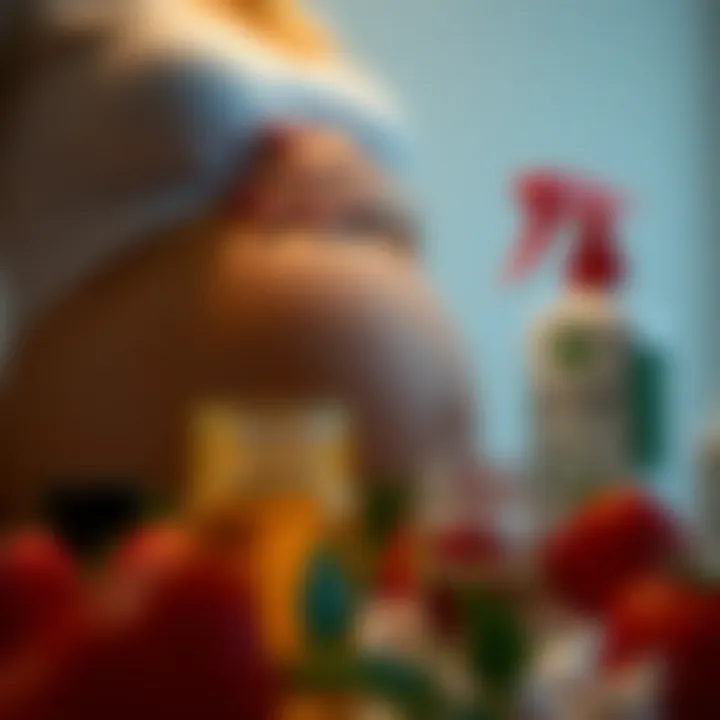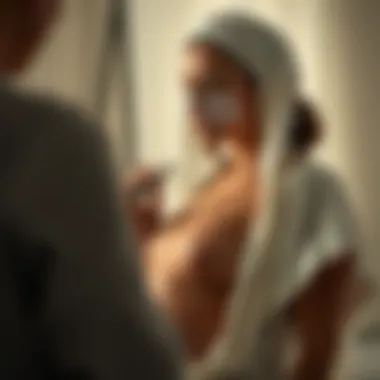Safe Cosmetics During Pregnancy: Key Insights and Tips


Intro
Navigating the world of cosmetics can feel daunting, especially during pregnancy when the stakes are higher. Expectant mothers face a barrage of information, opinions, and, quite frankly, contradictory advice about what’s safe and what’s not. The question on many minds is, how can you look your best while prioritizing the health of your baby? This guide aims to shed light on the intricate dance between beauty and safety.
The journey of pregnancy brings about significant physical changes, and many women seek to maintain a sense of self amidst those transformations. However, as the body goes through this life-altering process, the concern for the developing fetus becomes paramount. Chemicals often lurking in beauty products can pose unseen risks. By understanding what to avoid and what alternatives exist, pregnant women can keep their beauty routines intact without compromising their health or their baby's wellbeing.
In this article, we will delve deep into the types of cosmetic ingredients that pose a potential risk, highlight safe alternatives, and provide practical tips on how to navigate beauty regimens during pregnancy. We'll also touch on regulatory perspectives surrounding cosmetic safety, reinforcing the importance of making informed choices. To put it simply, this guide seeks to empower pregnant individuals by combining expert insights and recent research with actionable advice.
Understanding the Risks of Cosmetics During Pregnancy
When a woman finds out she is pregnant, her focus often shifts to ensuring the health and well-being of her developing child. One crucial, yet sometimes overlooked, aspect is the use of cosmetics. Pregnant women frequently grapple with skin changes, which might lead to heightened interest in beauty products. However, it’s paramount to fully comprehend the potential risks associated with cosmetics during this sensitive time. Understanding these risks helps expectant mothers make informed decisions that safeguard both their health and that of their baby.
The journey of pregnancy brings about hormonal changes that can make women's skin more reactive and sensitive. This means that an innocent look in the mirror could reveal unexpected side effects from previous go-to products. Moreover, the cosmetics landscape is littered with chemical ingredients that pose significant risks. A simple application of moisturizer or lipstick could expose both mother and fetus to harmful substances. Being aware of these potential hazards provides a roadmap for navigating the cosmetics choices that seek to enhance beauty without jeopardizing safety.
Hormonal Changes and Skin Sensitivity
During pregnancy, hormonal fluctuations can lead to various skin reactions. For instance, some women experience melasma, often referred to as the "mask of pregnancy," which causes brown patches on the skin. Others can find that their skin becomes oily or dry, adding complexity to their beauty routine. The sensitivity varies significantly from person to person, and previous allergic reactions can intensify. Therefore, a careful evaluation of all cosmetic products is vital.
Mild ingredients that once felt gentle can morph into irritants due to heightened sensitivity. This necessitates evaluating not only what products one uses but also their ingredients. It’s best practice to patch test new products on a small area of skin, ideally before diving in fully.
Exposure to Harmful Chemicals
Pregnant women should remain vigilant about the chemicals lurking in their beauty products. Many common cosmetics contain ingredients that raise alarm bells when it comes to fetal safety. Here’s a closer look at some of these concerns:
Potential links to birth defects
There’s a growing body of research aligning specific cosmetic ingredients with potential birth defects. Chemicals like retinoids, commonly found in anti-aging creams, have been reported to cause congenital disabilities if used during pregnancy. The embryological stage is incredibly critical, and any adverse chemical exposure could have lasting consequences. It’s essential for women to reconsider their skincare routines and prioritize products that avoid these risky ingredients.
Additionally, ingredients like parabens and phthalates have garnered scrutiny due to their potential hormonal disrupting effects. Evidence suggests that such chemicals may interfere with fetal development, leading to malfunctioning biological systems down the road. This underscores the importance of closely scrutinizing product labels and choosing brands that pledges transparency and safety.
Long-term effects on child development
The long-term implications of lacquered beauty and skincare choices can potentially shape a child’s development in subtle but damaging ways. Emerging studies confront the possibility that exposure to certain chemicals during gestation sets the stage for behavioral issues and other health concerns later in life. While some findings still require further study, they certainly raise a few eyebrows and warrant a thorough evaluation of the products one envisions using daily during pregnancy.
In grappling with this complex maze of cosmetic choices, it becomes imperative to look beyond surface-level benefits. Understanding the risks embedded in everyday beauty routines is vital in making informed decisions. Pregnant women should consider whether the instant glow or smoother skin provided by a product is worth the potential long-term risks to themselves and their child.
Key Ingredients to Avoid in Cosmetics
Navigating the cosmetic aisle can feel like walking through a minefield, especially when pregnant. With all the changes happening in a woman's body, the need to be cautious about what goes on the skin is more important than ever. Certain ingredients, while popular in many products, can pose risks to both the mother and developing baby. This section sheds light on key ingredients that should take a backseat during pregnancy.
Parabens and Phthalates
Usage in products
Parabens and phthalates are common preservatives and plasticizers found in many beauty and personal care items. Their primary role is to extend the shelf life of products and stabilize formulations. Because of their efficacy and low cost, many cosmetic brands include them in creams, shampoos, and lotions. However, this widespread use raises concerns, particularly for pregnant women.
Choosing products that are free from parabens and phthalates is crucial. These substances are notorious for mimicking estrogen in the body, and too much estrogen can lead to unwanted hormone fluctuations. The push for "paraben-free" labels isn't just marketing fluff; it's a call for safety that resonates with those who are expecting.
Health implications
The health implications of parabens and phthalates cannot be ignored. Recent studies suggest that these chemicals may potentially disrupt hormonal balance, which is particularly critical when carrying a child. Short-term exposure can lead to skin irritations, while long-term exposure has raised eyebrows over links to reproductive issues and developmental problems.
When selecting cosmetics during pregnancy, opting for products labeled as "free from parabens and phthalates" is wise. It may help ease the unconscious worry about what goes on the skin impacting fetal health.
Retinoids
Forms of retinoids
Retinoids, derived from Vitamin A, are commonly used for their anti-aging and skin-clearing properties. They come in various forms, such as retinol, retinaldehyde, and tretinoin, each suitable for specific skin conditions. While they can work wonders for maintaining skin health, their potency is a double-edged sword—especially during pregnancy.
Despite the benefits, the drawback of retinoids is susceptibility to absorption through the skin. They are powerful agents that can potentially impact developing fetuses, which raises concerns about their use during pregnancy. Therefore, steering away from products containing retinoids may be wise for expecting mothers.
Associated risks
The associated risks of using retinoids during pregnancy extend beyond skin irritation. Studies have indicated that high doses of Vitamin A can lead to teratogenic effects, resulting in birth defects. Even over-the-counter retinoids, often perceived as safe, carry risks that pregnant women should not overlook.


In essence, it’s best to consult with a healthcare provider before even considering the use of products containing any form of retinoid while pregnant. It’s a precaution that might save future heartache.
Formaldehyde and its Derivatives
Common sources
Formaldehyde is a common ingredient found in hair straightening treatments, nail polish, and certain facial creams. It can also show up under various names, such as formalin, methylene glycol, and paraformaldehyde. Awareness of where these derivatives lurk is crucial when picking up a product.
Many users are unaware of how these substances can impact health, especially during pregnancy. The prevalence of formaldehyde in everyday cosmetics is a critical point to consider. So, pregnant women should read labels carefully, as even seemingly benign products can harbor this notorious chemical.
Potential dangers
The potential dangers of formaldehyde and its derivatives have raised alarms in recent years. Exposure to this chemical has been associated with respiratory issues, skin irritations, and, more alarmingly, cancer risk. During pregnancy, formaldehyde can lead to complications, including increased risks of miscarriage and developmental issues in newborns.
For expecting mothers, avoiding products that contain this ingredient is paramount. When in doubt, opting for certified natural products may provide peace of mind and safety.
This overview on key ingredients to avoid underscores the importance of making informed choices during pregnancy. By being aware of the potentially harmful effects these chemicals might have, expecting mothers can help shield their babies from unnecessary risks.
Chemical Composition of Cosmetics and Health
Understanding the chemical composition of cosmetics is paramount for expecting mothers. During pregnancy, the skin undergoes various changes, becoming more sensitive and reactive. This sensitivity can amplify the body's response to certain chemicals, thereby influencing both maternal health and fetal development. Choosing the right products can significantly impact not only the mother's skin health but also ensure the safety of the developing baby. The implications of using unsafe products cannot be overstated, emphasizing the need for informed choices.
Understanding Cosmetic Labels
Deciphering ingredient lists
Deciphering ingredient lists is one of the most critical tasks for pregnant individuals seeking safe cosmetics. Each item on a label is listed in the order of concentration, allowing one to identify which ingredients dominate the product. The key characteristic of this process is its importance in identifying hazardous elements. For instance, if an ingredient like formaldehyde appears near the beginning of the list, it indicates a higher concentration, raising safety concerns.
Moreover, many consumers often overlook synthetic preservatives and fragrances, which can wreak havoc on sensitive skin. Knowing how to read these labels helps one to spot no-go ingredients effectively. However, the learning curve can be steep, especially for those unfamiliar with chemical nomenclature. To mitigate this, educational resources like National Institute of Health offer guidance on common cosmetic ingredients and their functions.
Identifying safe products
Identifying safe products is a task that requires diligence, especially for pregnant women. The hallmark of this practice lies in recognizing brands committed to transparency in their ingredients. Many major brands now formulate lines specifically for expecting mothers, free from harmful additives.
The unique feature here is the emphasis on certification. Some products bear seals from trusted organizations, indicating they meet specific safety standards, which adds a layer of reassurance. For example, patches like "non-toxic" or "dermatologist-approved" typically signify a more reliable choice. This obviously doesn’t come without potential disadvantages; however, as some brands may potentially overstate safety claims to market their products better. Therefore, it is crucial to consult platforms like Environmental Working Group to verify claims and track potential risks associated with specific products.
The Role of Absorption Rates
Skin absorption principles
Skin absorption principles provide essential insight into how chemicals enter the body. The skin acts as a barrier, but it is not entirely impermeable—certain substances can penetrate it and enter systemic circulation. This aspect is crucial during pregnancy as any absorbed substance has the potential to affect fetal development.
A beneficial aspect of understanding these principles is that consumers can make choices based on the molecular size of ingredients. For instance, smaller particles can penetrate more deeply, which raises concerns regarding their potential effects. Awareness of how ingredients interact with skin allows better-informed purchasing decisions.
How it impacts safety
How absorption rates affect safety brings to light the vital nature of ingredient formulation. Pregnant women are often advised to minimize the use of products with high absorption rates, particularly if those products contain questionable chemicals. The inherent characteristic of this awareness allows consumers to gauge possible risks effectively.
For example, products with mineral-based ingredients tend to have lower absorption rates compared to those with synthetic additives. Ultimately, this understanding empowers individuals to be vigilant about their cosmetic usage during pregnancy, enhancing safety while still maintaining their grooming routines. Resources such as FDA and academic journals on dermatology provide further insights on this matter.
Safe Cosmetic Alternatives for Expecting Mothers
The topic of safe cosmetic alternatives for expectant mothers holds immense significance in ensuring both maternal well-being and fetal health. Given the pronounced hormonal changes that a body undergoes during pregnancy, the skin can react differently to various products. It becomes imperative to choose cosmetics with care, weaving together safety with efficacy. Those carrying new life often find themselves scrutinizing labels more closely, and the allure of natural ingredients has gained traction.
Natural alternatives are gaining attention for their potential benefits. For instance, these products tend to evade the harsh chemicals often found in conventional cosmetics. Additionally, natural ingredients are less likely to cause irritation or allergic reactions. This is particularly advantageous during pregnancy when skin sensitivity can be heightened.
Natural and Organic Products
Benefits of natural ingredients
The allure of natural ingredients originates from their gentler composition, which may reduce the risk of harmful exposure. Products derived from plants or other natural sources often come with antioxidant properties, nourishing vitamins, and minerals. For expecting mothers, this can mean a combination of beauty and care. Essential oils like lavender or chamomile can provide fragrance and soothe stressed skin, contributing to overall skin health.
Furthermore, these ingredients align with a more eco-friendly and sustainable approach, promoting a lifestyle that also considers the planet's well-being. While natural products offer an impressive reputation, it’s essential to recognize that not all are created equal. Some could still cause unexpected allergic reactions, so a patch test is always wise.
"Opting for natural ingredients during pregnancy ensures beauty routines do not compromise health."


Brands to consider
When it comes to selecting safe brands, options are abundant. Brands like Burt’s Bees, 100% Pure, and Beautycounter have created their foundations on natural ingredients, offering products like lip balms, hand creams, and foundations that promote comfort rather than chemical exposure. The reputable brands vet their formulations to avoid harmful substances, making them a safer choice for pregnant women.
Another interesting aspect of these brands is their emphasis on transparency. Consumers can access detailed ingredient information, empowering the user to make informed decisions. However, while these brands typically offer safer alternatives, it's vital to remain vigilant as new products regularly enter the market, and ingredients can change over time.
Homemade Cosmetic Solutions
Basic recipes
Homemade cosmetic solutions present an exciting avenue for those looking to tailor their beauty regime according to personal needs and preferences. Utilizing simple kitchen staples, one can concoct a myriad of products—from scrubs and masks to moisturizers. For instance, a basic sugar scrub with olive oil can gently exfoliate while providing hydration, serving the dual purpose of effective beauty and safety. These DIY recipes often bypass the complexities of commercial products, leaning instead on pure, recognizable ingredients.
Additionally, there’s a certain joy in crafting one’s cosmetics. Experimenting with variations in formulation allows expectant mothers to control precisely what they apply to their skin.
DIY safety considerations
However, that leads us to safety considerations in homemade solutions. One must tread carefully; while the idea of crafting your beauty products seems appealing, hygiene is paramount. Ensure that all utensils and containers used are sanitized appropriately to avoid contaminants. Also, familiarize yourself with potential allergens, even in the most benign-looking ingredients. For instance, some natural oils can cause irritations for certain skin types.
Homemade solutions can be appealing as they are often tailored specifically for individual needs, yet they equally carry a risk of contamination or misformulation. Weighing the balance between creativity and safety is essential. Ultimately, awareness and care can lead women to achieve both elegance and safety in their beauty rituals.
Regulatory Perspectives on Cosmetic Safety
Navigating the world of cosmetics during pregnancy requires more than just personal choice; it’s essential to understand regulatory frameworks governing cosmetic safety. This section shines a light on the role regulations play in ensuring that products are safe for both the expecting mother and the developing fetus. The aim is to clarify how these standards work to create a safer environment for pregnant individuals amidst a myriad of products available in the market.
Understanding Cosmetic Regulations
Agencies overseeing safety
The agencies responsible for cosmetic safety have a fundamental role in maintaining public health standards. In the United States, the Food and Drug Administration (FDA) oversees the safety of cosmetics and personal care products. One key characteristic of the FDA’s oversight is that it requires companies to ensure their products are safe before marketing them to consumers.
An important feature of these agencies is their ability to enforce compliance among cosmetic manufacturers. This means that brands are held accountable for including harmful ingredients. However, the oversight by government agencies can sometimes be seen as limited since not all ingredients are evaluated with the same rigor.
For expectant mothers, understanding this landscape allows them to make informed decisions about the cosmetics they use.
Standards for pregnant individuals
Standards specifically meant for pregnant individuals are limited but crucial for safety. Certain guidelines advise companies to either eliminate or thoroughly evaluate the impact of specific ingredients on fetuses before including them in their products. These standards are designed keeping in mind the unique physiological changes women undergo during pregnancy, the heightened skin sensitivity, and the implications these may have for both mother and child.
A key aspect of these standards is the precautionary principle, which suggests that in the absence of scientific consensus, it’s better to err on the side of safety. This precaution ensures that manufacturers are proactive about the choices they make. While these standards do provide necessary guidance, they can sometimes be vague, leading to varying interpretations among manufacturers.
Challenges in Regulation Enforcement
Global discrepancies
One of the significant challenges in cosmetic regulation is the discrepancies that exist across different countries. In some regions, the regulations are stringent, while in others, they may be surprisingly lax. This inconsistency prompts a lot of confusion, especially for brands that operate globally.
Global discrepancies can cause safety gaps. It often becomes difficult for expecting mothers to ascertain which products are truly safe, as the same product could have different formulations depending on the market.
Public health implications
The implications of these regulatory challenges can greatly affect public health. In regions with weak regulations, there can be increased exposure to harmful chemicals, which potentially pose risks during pregnancy. Simply put, if expectant mothers are unaware of the risks associated with certain cosmetics, they may unknowingly jeopardize their child's health.
This part of our discussion serves to underline the importance of robust regulatory frameworks. Pregnant individuals must be aware of these factors as they navigate their choices, and this awareness can empower them to make informed decisions for their families.
"Knowing what goes into our cosmetics is vital not just for our beauty routine but for the healthy development of our babies."
In summary, the regulatory aspects surrounding cosmetic safety— from the agencies enforcing the rules to the differences in global enforcement— are crucial for understanding how safe products can be for use during pregnancy.
Expert Tips for Safe Cosmetic Use During Pregnancy
Navigating the world of cosmetics during pregnancy can be a tricky path, strewn with potential hazards that expecting mothers might be unaware of. As the body goes through remarkable changes, the choice of cosmetic products demands careful scrutiny. Understanding how to select safe options can not only protect the well-being of a mother but also take care of her growing baby.
A few simple guidelines can make all the difference in minimizing risks. Knowledge acts like a compass, guiding expectant mothers to safer choices. It isn't just about aesthetics; it's about ensuring that both mother and child stay healthy throughout this important time.
Consulting with Healthcare Providers


Importance of professional advice
When it comes to guidance on cosmetic use, consulting healthcare professionals can be invaluable. Doctors and dermatologists can assess individual circumstances, helping to tailor recommendations that fit a woman's unique health profile. The professional insight provides a backbone - reinforcing the confidence that the products chosen are safe for use during pregnancy.
Healthcare providers can offer evidence-based advice that considers specific health conditions or allergy histories, ensuring that every recommendation is personalized and relevant. This focus on individualized care is crucial; using products that a healthcare provider approves can dramatically reduce the chances of adverse reactions, making it a strong and popular recommendation in this context.
However, as beneficial as this approach is, there’s a unique challenge: not all professionals might be completely up-to-date with the latest cosmetic safety research. So while their advice is a vital feature, it’s best paired with thorough research and awareness of current safety standards in cosmetic products.
Dosing and exposure considerations
Understanding the level of exposure to cosmetic ingredients is another critical aspect of safety during pregnancy. How much of a product is being absorbed? This question holds significant weight in determining which cosmetics are truly safe. Studies suggest that some ingredients can be absorbed into the bloodstream and potentially affect fetal development.
Given this concern, it’s essential to engage with healthcare providers to gain insights on the acceptable dosage of specific ingredients. Knowing the right amount can empower mothers to make informed decisions. This approach is particularly popular because it asks for a proactive stance on health amidst the myriad uncertainties of pregnancy.
Moreover, while some products might contain seemingly safe components, the cumulative exposure to multiple products over time could be detrimental. Hence, being mindful of how much and how often one uses certain cosmetics can offer a protective layer. Taking the time to discuss these factors with professionals enhances awareness and forms a dialog around health safety.
Personal Care Routines
Creating a safe regimen
Establishing a consistent and safe personal care routine is vital for expecting mothers. This means not just following trends but grounding choices in practicality and safety. A regimen that focuses on minimalism can often be more beneficial. Streamlining products can limit exposure to harmful ingredients, which is particularly effective during this sensitive time.
A tailored regimen can specifically incorporate products marked as pregnancy-safe, emphasizing effectiveness without compromising health. The uniqueness of this approach lies in its ability to cover essential beauty needs without creating unnecessary exposure to harmful substances. Balancing health with beauty wishes doesn’t have to be a tightrope act; it can be straightforward with mindful preparation.
On the flip side, a limited range of cosmetics means fewer options, which could be frustrating for some. But, by carefully evaluating products and their ingredients, mothers can curate a list that meets both safety and personal preferences.
Monitoring product reactions
Once products have been selected and a regimen established, the next step is to closely monitor how the body responds. Pregnancy can change skin types and sensitivities. A product that was tolerable before might lead to breakouts now, or vice versa. Being vigilant in tracking any adverse reactions is crucial.
This monitoring not only helps fine-tune a beauty routine but also provides an early signal of why certain products should be discarded. Expectant mothers might find that keeping a beauty journal can be instrumental; recording how skin reacts to various products — sometimes even noting dates — can help identify triggers and ensure safety. It’s a beneficial and practical approach to preventing unintentional harm during a period full of change.
In summary, the journey to maintaining personal beauty during pregnancy can be navigated with awareness and informed decisions. By enlisting healthcare guidance, being conscious of exposure, establishing robust routines, and carefully monitoring reactions, mothers can safely indulge in their cosmetic practices while prioritizing health.
Emerging Research in Cosmetic Safety
The landscape of cosmetic safety for pregnant individuals is undergoing significant changes, thanks to emerging research. This topic is not just about keeping up with the latest trends in products; it’s about understanding how these products affect health, especially in a condition as delicate as pregnancy. With new studies surfacing regularly, it’s crucial to stay informed and discerning. The findings from these researches provide essential insights that not only shape consumer preferences but also guide manufacturers in developing safer products. Therefore, tracking these developments can empower expectant mothers to make informed choices, ensuring the well-being of both themselves and their babies.
Recent Studies on Cosmetic Ingredients
Findings related to pregnancy
Recent studies have shed light on the impact of various cosmetic ingredients during pregnancy. One key area of focus is how certain chemicals can pass through the skin and potentially affect fetal development. For instance, some researchers examined how common ingredients like parabens and phthalates may disrupt hormonal balances, which is a significant concern for expectant mothers. The results show that pregnant individuals can have heightened sensitivity to these compounds.
The research highlights an important characteristic: the potential for ingredient accumulation in the body over time, which could pose long-term risks to fetal health. This makes it imperative for pregnant women to scrutinize product labels carefully. The ability to identify these harmful components leads to a safer regimen for skincare, thereby enhancing maternal and fetal health.
"Understanding the link between cosmetic ingredients and pregnancy outcomes is crucial in turning the tide toward safer beauty practices."
Impact on fetal development
Another significant aspect of ongoing research pertains to how certain cosmetics affect fetal development directly. Findings suggest that exposure to certain chemicals not only affects the mother but can lead to developmental complications in the unborn child. For instance, substances like retinoids, when absorbed in high amounts, can lead to birth defects. This aspect underscores the vital need for pregnant individuals to avoid cosmetic products that contain these potentially harmful substances.
The unique feature of this research is how it underscores the interplay between environmental exposure and fetal health. Highlighting these concerns, the studies advocate for a more cautious approach to cosmetic use during pregnancy. Understanding this connection provides a pathway to safer choices, making it a critical factor in this comprehensive discussion around cosmetic safety.
Future Trends in Safe Cosmetics
As we look towards the horizon, it's clear that innovation in cosmetic formulation will play a big role in creating safer products for pregnant users. The focus is shifting from merely avoiding harmful ingredients to actively seeking out safer alternatives that support maternal health.
Technological advancements
Innovative technologies that enhance product safety are becoming more prevalent. Research in bioengineering is leading to the creation of compounds that are not only effective but also devoid of harmful properties. For instance, some labs are developing plant-based alternatives that mimic the effects of traditional cosmetics without the associated risks. These technological advancements represent a promising shift towards transparency in ingredient sourcing, helping consumers find safe products tailored to their unique needs.
The advantageous aspect of this trend lies in its alignment with environmental consciousness while maintaining efficacy in cosmetic performance. Such innovations encourage brands to pursue safer, more effective formulations, marking a turning point in the industry that aligns with growing health awareness among consumers.
Changing preferences in consumers
Lastly, understanding consumer preferences plays a pivotal role in shaping the future of cosmetics during pregnancy. With a growing demand for transparency and safety, brands are now pressured to reformulate their products accordingly. The trend shows that expectant mothers are becoming savvy shoppers, increasingly prioritizing ingredients they can trust over flashy marketing claims.
This shift not only reflects a heightened awareness of personal health but also highlights a demand for ethical practices within the cosmetic industry. The unique feature of these changing preferences is that they embody a collective movement towards prioritizing health over mere aesthetics, leading to products that are genuinely safe for both mother and child.
As this trend continues to grow, it raises the stakes for companies to remain accountable and responsive to consumer concerns, ultimately benefiting everyone involved.







